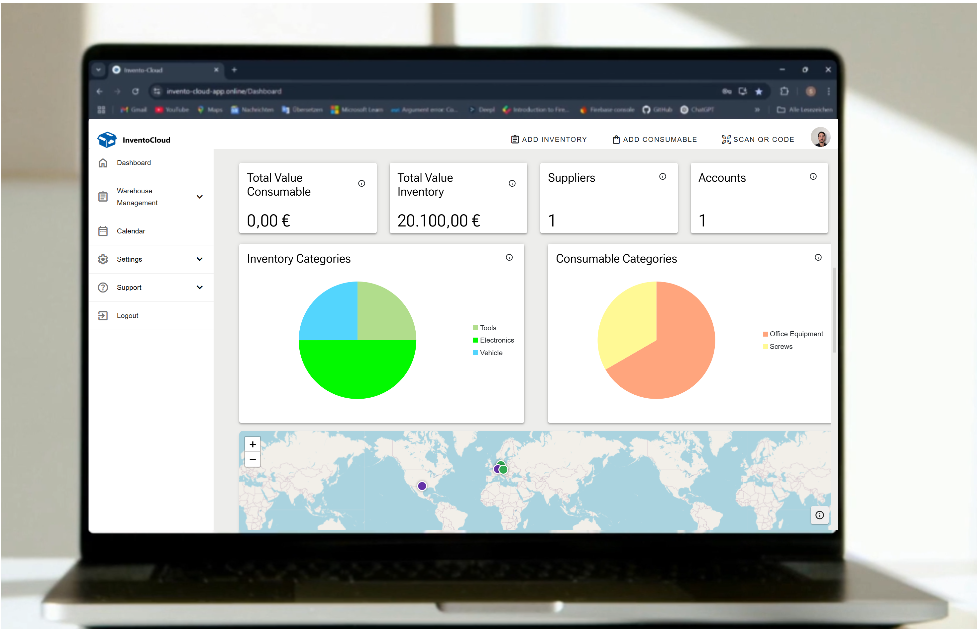Here’s the expanded text in English, presented as a flowing article:
Why Inventory Management Software Is Essential for Modern Businesses

In today’s fast-paced business environment, maintaining an accurate, real-time view of your assets is no longer a luxury—it’s an absolute necessity. As the founder of InventoCloud, I’ve seen firsthand how companies of all sizes struggle with spreadsheet overload, misplaced equipment, and unpredictable stockouts. Implementing a dedicated inventory management solution transforms these pain points into predictable, scalable processes. Let’s take a deep dive into the reasons why your business needs inventory management software now more than ever.
Dramatically Improved Efficiency
Manual record-keeping in Excel or with paper logs is slow, error-prone, and incredibly difficult to scale. With modern inventory management software, you’ll experience significant improvements:
- Instant Updates: Every check-in, check-out, or transfer is recorded in mere seconds, eliminating the need for tedious data re-entry.
- Barcode & QR Scanning: Utilizing mobile or desktop scanning capabilities drastically reduces human error and speeds up tedious stock counts.
- Automated Alerts: Low-stock notifications and reorder reminders ensure you can act proactively, addressing potential shortages before they impact your operations.
The immediate result is that your teams spend less time on administrative tasks and can allocate more effort to revenue-generating activities.
Complete Cost Visibility
Hidden inventory costs can severely erode profit margins. An effective inventory platform provides unprecedented financial clarity:
- Capital Tied Up: Real-time dashboards give you a precise understanding of exactly how much money is parked in slow-moving or obsolete stock.
- Maintenance Tracking: Easily schedule and log every service event for equipment, preventing costly downtime and extending asset lifespan.
- Depreciation Monitoring: Accurately track asset depreciation over time, providing crucial data to inform budgeting and replacement decisions.
Ultimately, you gain tighter control over expenditures and can make much more informed financial decisions.

End-to-End Traceability
Regulated industries, rental businesses, or any company tracking high-value items will immensely benefit from comprehensive traceability features:
- Audit Trails: Every asset comes with a complete history of acquisitions, movements, repairs, and disposals, which is ideal for compliance requirements and internal audits.
- User Accountability: Assign clear ownership for each item. You’ll always know who last handled each item and precisely when.
- Location Awareness: Map your equipment across warehouses, job sites, or departments in real-time, providing immediate visibility into asset location.
This enhanced traceability helps you reduce losses, streamline audits, and significantly boost accountability across your entire organization.
Enhanced Collaboration & Access Control
Inventory isn’t just a warehouse problem—it touches purchasing, finance, maintenance, and operations. A unified inventory system fosters seamless collaboration:
- Role-based Permissions: Define precisely who can view, edit, or approve specific transactions, ensuring data integrity and security.
- Multi-user Editing: Team members, whether in different offices or facilities, can work simultaneously without encountering data conflicts.
- Commenting & Notes: Embed contextual notes directly on assets (e.g., „Needs calibration after next use“), providing crucial information at a glance.
The outcome is that cross-department workflows run smoothly, and every stakeholder has the appropriate level of visibility to perform their tasks effectively.
Scalability for Growth
As your business expands, so do your inventory complexities. Modern software platforms are built to grow with you:
- Configurable Data Models: Easily add custom fields (e.g., warranty expiry, inspection intervals) without needing developer support.
- Integration Frameworks: Connect seamlessly with your existing ERP, accounting tools, IoT sensors, or e-commerce platforms for a unified ecosystem.
- Cloud-based Accessibility: With no on-premise servers to maintain, your team can securely log in and access inventory data from anywhere with internet access.
Your inventory system will thus grow in lockstep with your evolving business needs, avoiding costly and disruptive migrations down the road.
Data-Driven Insights
Static reports are a thing of the past. Today’s leaders demand dynamic, actionable insights:
- Real-Time Dashboards: Visualize current stock levels, asset utilization rates, and overall inventory value at a glance.
- Predictive Analytics: Identify usage trends and accurately forecast future demand, allowing you to optimize purchasing decisions.
- Custom Reporting: Drill down into granular data—by location, category, or supplier—to uncover hidden inefficiencies and opportunities.
These powerful insights allow you to pivot faster, seize market opportunities, and eliminate critical blind spots in your supply chain.

Higher Employee Satisfaction
Nothing frustrates staff more than endlessly hunting for missing tools or meticulously reconciling conflicting records. Inventory software delivers tangible benefits to your workforce:
- Intuitive Interfaces: Modern dashboards and mobile apps make onboarding new team members quick and painless.
- Reduced Fire Drills: Fewer emergency stock purchases or service escalations mean calmer, more productive teams.
- Clear Processes: Standardized workflows reduce ambiguity and free employees to concentrate on their core responsibilities.
The ultimate result is happier teams, lower turnover, and a stronger, more positive company culture.
Getting Started: Best Practices
To ensure a smooth implementation and maximize the benefits of your new inventory management system, consider these best practices:
- Pilot with a Small Team: Roll out the system to one department first to gather valuable feedback and fine-tune settings before a broader deployment.
- Define Clear Workflows: Before going live, clearly map out who handles receiving, issuing, and auditing tasks.
- Train & Communicate: Host concise training sessions and clearly articulate how the new system will benefit each user in their daily tasks.
- Review & Refine: Utilize the built-in reports to identify bottlenecks or data gaps, then adjust permissions or processes as needed.
Conclusion & Call to Action
Inventory management isn’t just about counting stock—it’s about unlocking operational excellence, tightly controlling costs, and empowering your team with reliable, real-time data. Don’t let outdated processes hinder your business’s potential for growth and efficiency.
Ready to see the difference for yourself? Start your free 7-day trial of InventoCloud today and experience streamlined inventory control from day one.


Schreibe einen Kommentar